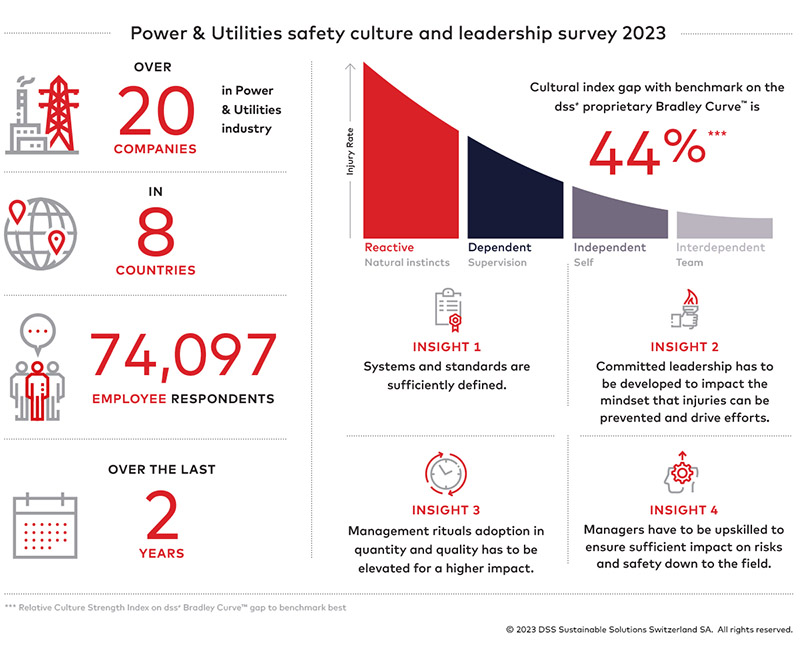Why P&U senior leaders need to transform risk management
The trend for fast transformation in the power and utility sector including the move from conventional energy to renewable energy, decarbonisation and the adaptation to volatility provides exciting opportunities but major operational risks challenges.

The pressure to rapidly transform business and operations is increasing as it is necessary to capture capital investment and growth, but this rapid transformation also exposes companies and their workers to new risks. This should be looked at in the boardroom as conditioning the transformation and the most significant risk it brings, which is loss of life, should be seen as a threat that also reveals major business opportunities.
Power and utility companies simply can’t be sustainable and contribute to solving the climate crisis if they continue to face material issues such as having serious injuries and fatalities (SIFs), which also causes a lack of trust in their ability to transform, manage risks, perform and be competitive.
# Volatile landscape
All the major power and utilities companies in Europe have tilted their strategy to reach net zero goal by 2030/2050. To do so, major business transformations are already happening to grow in renewables, reduce consumptions, adapt grids, and integrate new technologies.
These transformations require new supply chains, rapid recruitment, and an increase of third-party contracted work as well as the transition to new energies, different operating models, and technologies.
According to SolarPower Europe and WindEurope associations, in 2022 the EU had a solar and wind workforce of 650,000 employees, which is set to double in less than a decade. Whilst workers may be less exposed to existing known risks, such as the ones of conventional thermal assets, there are now new risks to anticipate such as the ones resulting from systems that are continuously powered, biomass and alternative fuels, light but challenging structural work and even hydrogen.
A further dynamic is that companies are building or acquiring new assets whilst maintaining ageing ones. In addition, the move also alters the organisational footprint, adding to traditional fixed units that are company or client-based (such as power plants, heating production units and facilities at industrial sites) and a much more dispersed operational workforce including workers and contractors at private dwellings or remote terrains. This inevitably means that managers have fewer local and timely opportunities to implement operating standards, enforce operating discipline and ensure safe operating procedures are in place. It should therefore be no surprise that we are seeing a worrying trend in SIFs.
There is immense pressure to transform at an ever-increasing pace, leading to companies not addressing and anticipating the reality of future construction work and operations. SIFs are revealing management’s ability to manage operations and their transition. So how can the devastating impacts of SIFs be prevented quickly and efficiently thus addressing an opportunity to future-proof businesses?
# Risk profile
Understanding the risk profile of actual and future operations is key. Managers will not only have to prioritise prevention actions on top risks but also develop sufficient awareness of critical safety barriers and controls required to ensure robust and effective implementation.
The infographic below confirms that managers struggle in developing the risk profile understanding and elevating awareness and focus on the right level down to operations.
The risk profile must consider several dimensions as the conventional risk suppression, reduction and mitigation approach are not enough. It is fundamental to consider the robustness of barriers, the required operating discipline and the consistency of implementation. With transformations going forward in the industry, the risk profile is evolving in the nature and magnitude of risks. The characteristics of populations and organisations are changing, resulting in managers needing to elevate their risk recognition capabilities.
Managers should develop their ability to recognise risks in order to focus efforts on the most critical ones. The high pace of transformation, lack of time, complexity, and fragmentation of some organisations now require excellence in focusing the time spent on safety but more specifically the time spent on the critical risks.

# Efficient Upskilling or Reskilling
To manage critical operational risks and ensure incident-free operations, leaders and managers need both a high level of committed leadership to elevate culture, impact mindsets and behaviours, as well as abilities to understand and anticipate the risk profile.

Companies should be focusing on accelerating skills development across their existing population of leaders and managers, rather than concentrating on immediate challenges such as an ageing workforce and the consequent loss of expertise or focusing on positions that are proving difficult to fill.
Upskilling managers now will also help them to cope with the future demands that go with the energy transition and the major business transformations to reach net zero 2030/2050 goals in Europe.
Managers in number and capabilities are already a scarce resource, dealing with multiple business and operations transformation initiatives, therefore mobilising them on a safety performance improvement journey only works if it’s done efficiently.
It is not about deploying intensive training, removing managers from operations to be in a classroom or spending time on eLearning programs. It is about providing them efficient and impactful support in daily life, during their management rituals, improvement initiatives, field interactions and any moment they must impact the mindsets and behaviours of their teams on the key risks. dss+ recommends in situ coaching to be at the core of the safety performance improvement journey, to ensure efficiency, rapid practical skills elevation, and high sustainable impact.
# Accelerate the time to impact
When addressing SIFs companies know they have no time to wait, but they struggle in identifying and implementing the actions that will pay off as well as addressing organisational complexity and specificities. On the one hand, a strong push comes from the top and mobilises and stimulates the whole organisation, but on the other hand, a structured programme needs to be properly designed and rolled out knowing it’s not a one-size-fits-all approach. Perimeters will have different risk profiles, organisational characteristics, as well as different levels of maturity and performance to consider.
To achieve this, dss+ recommends businesses focus on specific areas of the organisation individually to streamline and accelerate the transformation process. Each project is labelled as an ‘area of transformation’ or an AoT, this could be a particular business process, a technology, a team, an entire department, or a production unit. It’s a case of identifying and focusing on the specific area to drive and achieve the desired transformation objectives.
Over a recent dss+ sample of 12 large safety transformation programmes, reaching more than 25,000 managers, we have confirmed that a 24-week upskilling or reskilling programme enables companies to reverse the trend of declining safety performance and reach the necessary autonomy for sustainable results. The approach starts by quickly understanding the situation with rapid diagnostics to confirm the areas and risks to focus on and the key actions, engaging leadership with implementation decisions, visible actions and then supporting deployment.
4 key actions to initiate your transformation
Surface the burning platform:
Surprisingly, a worrying trend in performance can be hidden when looking at traditional safety KPIs. Quite often a low Lost Time Injury Frequency Rate (LTIFR) and a few severe events tend to reassure leaders that safety management is under control and that future performance is secured. But it is all about capturing low-intensity signals, such as an elevation of high potential events and near misses, the easy observation of unsafe acts in the field with no real management reaction, production losses, planning slippage - or interestingly a relative improvement of those, on paper, revealing a tendency to overlook the problem and to under-report. Furthermore, actual KPI trends do not tell you about the future risks organisations will have to cope with, and managers need to develop the ability to anticipate future risk profiles.
Articulate the business case:
Potential consequences but also underlying benefits must resonate in the boardroom prior to starting any transformational initiative. Sizing the outcomes and developing the business narrative that supports the opportunity to launch a safety transformation programme is a prerequisite for alignment and further acceleration. With that regard, many companies look at potential savings from incident reduction but underestimate the strategic benefits they can gain on operational excellence, predictability, attractiveness, and competitiveness.
Evaluate current initiatives and capabilities to support:
Facing such challenges, organisations will first have to review the portfolio of current improvements initiatives and understand if these will deliver the expected outcomes.
They also have to look at their internal HSE capabilities and consider organisational adjustments to ensure closeness of support to operations, availability of expertise or delivery of training. But frequently the speed, depth of change and nature of support required will exceed HSE organisations’ capabilities and capacities. When a rapid step change in performance is expected, the need for external support to accelerate and secure the impact of transformation is often confirmed.
Identify success factors:
To secure the benefits of such transformations it is important to identify and ensure that success factors are in place. Of course, starting from the top, giving strong sense of purpose, and keeping the momentum is required. It is also about the adaptation of the deployment strategy, level of support and prioritisation to each perimeter specificities. For such initiatives targeting managers, critical mass considerations are important, first improvement signals are visible when a critical mass of 25% of managers are upskilled or reskilled, for sustained impact this critical mass must be further increased and maintained above 75%.
Recognising and addressing the latent challenges in safety management is paramount, as it goes beyond incident reduction, extending to strategic benefits such as operational excellence and competitiveness in a rapid growth scenario. Evaluating internal capabilities is a crucial step as it directly impacts the journey toward a safety transformation, that demands vigilance, strategic alignment, and a continuous commitment to upskilling and reskilling managers.
dss+ recognises the challenges that companies in the Power and Utilities industry face as they strive to swiftly adapt to the sector’s expanding demands while effectively addressing the rising trend of Serious Injury and Fatality (SIF). To assist our clients in navigating these complexities, we offer clients our expertise in management upskilling and reskilling programmes, aiming to equip them with the tools not only to manage the evolving business landscape but also to affect meaningful business transformation.
Author

